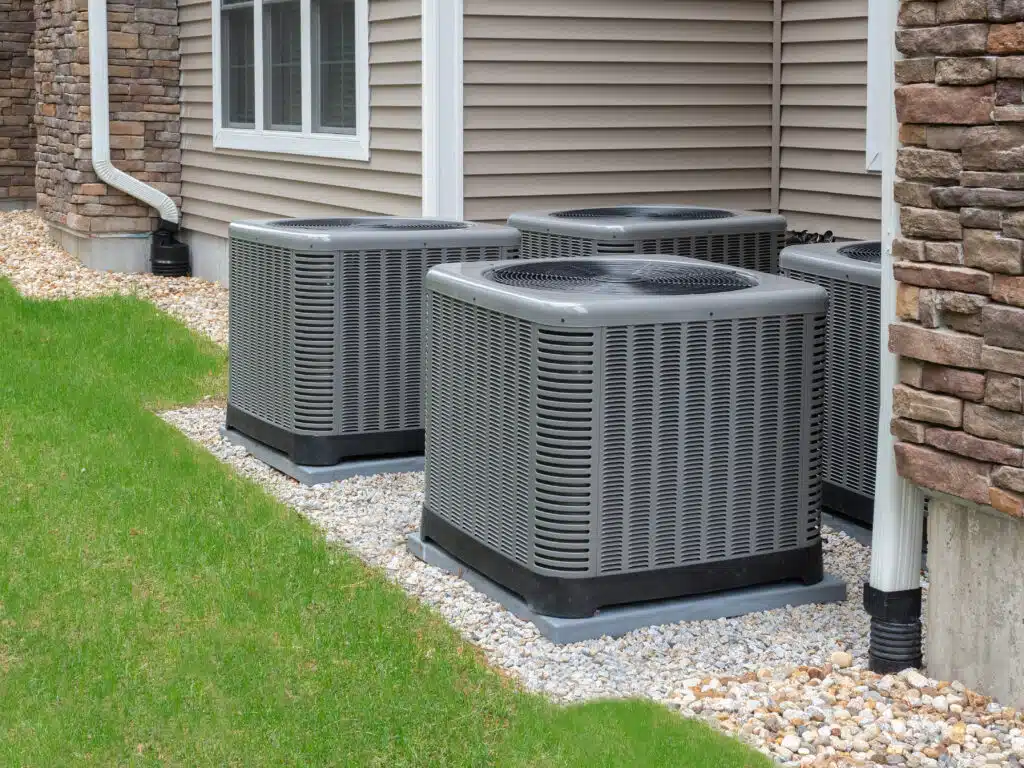
The Future of HVAC: Exploring AI-Powered Climate Control
Are you ready to discover how AI-powered climate control is transforming HVAC systems?
The integration of artificial intelligence (AI) in heating, ventilation, and air conditioning (HVAC) is revolutionizing how we manage indoor environments. Traditional HVAC systems operate on preset schedules and manual adjustments, often leading to inefficiencies and higher energy costs. In contrast, AI-driven systems continuously learn and adapt to provide optimal comfort and energy savings.
AI-Powered Climate Control introduces smart algorithms that analyze data from various sources, such as sensors, weather forecasts, and user preferences. These algorithms then make real-time adjustments to HVAC settings, ensuring maximum efficiency and comfort. AI-Powered Climate Control’s ability to process and respond to large volumes of data instantaneously sets it apart from conventional systems.
AI-powered HVAC systems are at the forefront of transforming how we control indoor climates. They offer unparalleled efficiency, comfort, and sustainability, making them an essential component of modern building management.
Understanding AI in HVAC Systems
Are you curious about how AI in HVAC systems works and what makes it so effective?
Definition and Components of AI-Powered Climate Systems
AI-powered HVAC systems leverage advanced technologies to automate and optimize climate control. These systems consist of several components, including:
- Machine Learning Algorithms: These algorithms analyze data patterns and make predictions to adjust the HVAC system’s operations.
- Internet of Things (IoT) Devices: Connected devices, such as smart thermostats and sensors, collect real-time data on indoor and outdoor conditions.
- Smart Sensors: These sensors monitor various parameters, such as temperature, humidity, and occupancy, to provide accurate data for the system to process.
Key Technologies: Machine Learning, IoT, and Smart Sensors
Machine learning (ML) is at the heart of AI-powered HVAC systems. It enables the system to learn from past data and make informed decisions about future operations. For example, an ML algorithm can predict when a room will be occupied and adjust the temperature accordingly, ensuring comfort without wasting energy.
IoT connects various HVAC components, allowing them to communicate and work together seamlessly. Smart thermostats, air quality sensors, and other IoT devices gather and share data, creating a comprehensive picture of the indoor environment. This data integration is crucial for the AI to function effectively.
Smart sensors provide the data needed for AI algorithms to make accurate adjustments. These sensors detect changes in temperature, humidity, and occupancy, among other factors. By continuously monitoring these parameters, the sensors ensure that the HVAC system responds promptly to any changes, maintaining optimal conditions.
Benefits of AI-Powered Climate Control
How can AI-Powered Climate Control systems revolutionize your home or business?
Energy Efficiency and Cost Savings
One of the primary benefits of AI-Powered Climate Control systems is energy efficiency. Traditional HVAC systems often run at fixed intervals, regardless of actual need, wasting energy.
AI-powered climate control systems, however, continuously analyze data from sensors and other inputs to adjust heating and cooling dynamically. This means the system only uses energy when necessary, significantly reducing consumption. The result is lower utility bills and reduced energy waste, making AI-powered HVAC systems a smart investment for both homeowners and businesses.
Enhanced Comfort and Personalized Settings
AI-powered climate control systems provide enhanced comfort by learning from user behavior and preferences. Over time, the system gathers data on your habits, such as preferred temperatures at different times of the day or in various rooms. It then uses this data to create personalized climate settings, ensuring that your environment is always comfortable. For instance, the system might lower the temperature in your bedroom before you go to sleep and raise it in the morning before you wake up. This level of customization is unmatched by traditional HVAC systems, offering a tailored indoor climate experience.
Environmental Impact: Reducing Carbon Footprint
Reducing the carbon footprint is another significant benefit of AI-Powered Climate Control systems. By optimizing energy usage, these systems contribute to lower greenhouse gas emissions. Traditional HVAC systems can be inefficient and overuse energy, contributing to higher carbon emissions.
In contrast, AI systems precisely manage energy consumption, minimizing waste and promoting sustainability. This not only benefits the environment but also helps homeowners and businesses meet their sustainability goals.
AI-powered HVAC systems offer numerous benefits, including energy efficiency, cost savings, enhanced comfort, and a reduced carbon footprint. By continuously learning and adapting to user behavior and environmental conditions, these systems ensure optimal performance and sustainability.

AI and Smart Thermostats
Have you ever wondered how AI enhances smart thermostats and makes them more efficient?
How AI-Powered Climate Control Enhances Smart Thermostats
Smart thermostats equipped with AI-Powered Climate Control systems can do much more than just maintain a set temperature. They use advanced algorithms to learn your daily routines and preferences. This learning process allows the thermostat to predict when you will be home, when you’ll be away, and how to adjust the temperature accordingly.
For example, if you typically leave for work at 8 AM, the AI will start reducing the heating or cooling output shortly before you leave, saving energy without compromising comfort. Upon your return, the system will ensure your home is at the perfect temperature.
Adaptive Learning in HVAC Systems
How does adaptive learning in HVAC systems enhance your comfort and efficiency?
AI Learning from User Behavior
Adaptive learning is a key feature of AI-Powered Climate Control systems. These systems collect data on your daily habits, such as when you adjust the thermostat, your preferred temperatures at different times of the day, and your occupancy patterns.
By analyzing this data, the AI-Powered Climate Control system creates a detailed profile of your preferences. For instance, if you like your bedroom cooler at night, the system will learn this and automatically adjust the temperature before you go to bed. This learning process ensures that your HVAC system is always aligned with your comfort needs, without requiring constant manual adjustments.
Real-Time Adjustments and Predictions
The ability to make real-time adjustments is another significant advantage of adaptive learning in HVAC systems. Traditional systems rely on preset schedules and manual inputs, which can lead to inefficiencies.
In contrast, AI-Powered Climate Control systems continuously monitor real-time data from sensors and other sources. They can detect changes in temperature, humidity, and occupancy, and adjust the system’s output accordingly. For example, if the AI detects that a room has become unoccupied, it can reduce heating or cooling to save energy. Conversely, it can increase output when it senses occupancy, ensuring comfort.
The Role of Predictions
Predictions play a crucial role in the efficiency of AI-Powered Climate Control systems. By using historical data and current trends, the AI can anticipate future needs and adjust the system proactively. For example, if the system knows that a heatwave is expected in the coming days, it can begin pre-cooling the house during off-peak hours to avoid straining the system during peak times. This predictive capability not only enhances comfort but also optimizes energy usage, reducing costs and environmental impact.
Adaptive learning in HVAC systems leverages AI to learn from user behavior, make real-time adjustments, and predict future needs. This results in a more comfortable, efficient, and sustainable climate control solution.
AI in Air Quality Management
Did you know that AI in HVAC systems can significantly improve indoor air quality?
Monitoring and Improving Indoor Air Quality
AI-Powered Climate Control systems go beyond temperature control; they also focus on maintaining optimal indoor air quality (IAQ). These systems use smart sensors to continuously monitor air quality parameters such as levels of carbon dioxide (CO2), volatile organic compounds (VOCs), particulate matter (PM), and humidity.
By analyzing this data in real-time, the AI can detect poor air quality and take immediate action to rectify it. For example, if the system detects high levels of CO2, it can increase ventilation to bring in fresh air, ensuring a healthier indoor environment.
Sensors and Data Analysis
The backbone of AI-Powered Climate Control management is a network of sensors strategically placed throughout the building. These sensors provide continuous, precise measurements of various air quality indicators. The data collected by these sensors is then analyzed by AI algorithms to identify trends and anomalies.
The system can pinpoint sources of pollutants, track changes over time, and predict potential air quality issues before they become problematic. This proactive approach allows for timely interventions, such as adjusting ventilation rates or activating air purifiers.
Benefits of AI in Air Quality Management
- Healthier Living Environments: By maintaining high air quality standards, AI-powered HVAC systems help reduce the risk of respiratory problems, allergies, and other health issues associated with poor indoor air quality.
- Energy Efficiency: AI optimizes ventilation based on actual air quality needs rather than running on fixed schedules. This targeted approach saves energy while ensuring fresh air supply.
- Comfort: Improved air quality contributes to overall comfort. Occupants experience fewer irritants, better sleep quality, and a more pleasant indoor atmosphere.
integrating AI-Powered Climate Control into HVAC systems for air quality management offers significant benefits. These include healthier indoor environments, enhanced energy efficiency, and improved comfort. By continuously monitoring and analyzing air quality data, AI-powered systems ensure optimal indoor air conditions.
Remote Control and User Interfaces
Have you ever wished you could control your HVAC system from anywhere, at any time?
Advantages of Remote Monitoring
Remote monitoring is a game-changer for HVAC systems. With AI integration, users can now control and monitor their HVAC systems from their smartphones, tablets, or computers. This feature offers several advantages:
- Convenience: Adjust your home’s climate settings from anywhere. Whether you’re at work, on vacation, or just lounging on the couch, you can ensure your home is always at the perfect temperature.
- Energy Savings: Remote control allows you to make real-time adjustments based on your schedule. Forgot to turn off the AC before leaving? Simply access the app and adjust the settings, saving energy and reducing costs.
- Peace of Mind: Monitor your HVAC system’s performance and receive alerts if something goes wrong. Early detection of issues can prevent costly repairs and ensure your system runs efficiently.

User-Friendly Interfaces and Mobile Apps
The success of remote control in HVAC systems largely depends on the user interface. Modern AI-powered climate Control systems come with intuitive, user-friendly interfaces designed to make climate control easy and accessible. Here are some key features:
- Simple Navigation: Apps are designed with the user in mind, featuring easy-to-navigate menus and clear options. Users can quickly access different functions without getting lost in complicated settings.
- Real-Time Data: View real-time data on your home’s temperature, humidity, air quality, and energy usage. This information helps you make informed decisions about your HVAC settings.
- Customization: Set personalized schedules and preferences. The system learns from your adjustments and makes recommendations to enhance comfort and efficiency.
- Voice Control Integration: Many AI-powered systems integrate with voice assistants like Amazon Alexa and Google Assistant. This allows for hands-free control, making it even more convenient to manage your HVAC system.
Benefits for Homeowners and Businesses
For homeowners, the ability to control and monitor HVAC systems remotely translates into greater comfort and cost savings. You can ensure your home is always comfortable while optimizing energy use based on real-time needs.
For businesses, remote control features can lead to significant operational efficiencies. Facility managers can oversee multiple systems from a central location, ensuring all buildings are running optimally. This reduces the need for on-site staff and allows for quick response to any issues that arise.
remote control and user-friendly interfaces are integral components of AI-powered HVAC systems. They offer unparalleled convenience, energy savings, and peace of mind for both homeowners and businesses.
Predictive Maintenance with AI
Are you ready to discover how predictive maintenance with AI can keep your HVAC system running smoothly?
Fault Detection and Diagnostics
One of the standout features of AI-powered HVAC systems is their ability to perform predictive maintenance. Traditional HVAC systems typically operate until a fault occurs, leading to unexpected downtime and costly repairs. In contrast, AI systems continuously monitor the performance of all components and detect any deviations from normal operation.
Using advanced algorithms, they can identify potential issues before they escalate. For example, if a motor is drawing more power than usual, the system will flag this as a potential problem, allowing for timely inspection and maintenance.
Proactive Maintenance to Reduce Downtime
Proactive maintenance is all about preventing problems before they occur. By analyzing data from sensors and other sources, AI systems can predict when a component is likely to fail. This foresight enables maintenance teams to address issues during scheduled maintenance windows rather than in response to emergencies.
As a result, the overall reliability of the HVAC system improves, and downtime is significantly reduced. Regular, planned maintenance also tends to be less expensive than emergency repairs, leading to cost savings.
Benefits of Predictive Maintenance
- Increased System Lifespan: Regular, proactive maintenance helps to extend the life of HVAC components. By addressing wear and tear early, you can avoid the premature replacement of parts.
- Energy Efficiency: A well-maintained system operates more efficiently. Predictive maintenance ensures that all parts are functioning optimally, which reduces energy consumption and lowers utility bills.
- Improved Comfort: Consistent performance means fewer breakdowns and a more stable indoor climate. This leads to a more comfortable environment for occupants.
- Cost Savings: Preventive measures and early fault detection help avoid expensive emergency repairs. Maintenance can be scheduled during less critical times, reducing disruption and saving money.
Practical Applications
In commercial settings, predictive maintenance is particularly valuable. Large facilities often have complex HVAC systems with numerous components. AI-powered predictive maintenance helps facility managers keep track of all equipment and ensures that any issues are addressed promptly. This proactive approach minimizes disruptions and keeps the environment comfortable for employees and customers.
For homeowners, predictive maintenance means peace of mind. Knowing that your HVAC system is being monitored and maintained automatically allows you to focus on other aspects of home management without worrying about sudden breakdowns.
Predictive maintenance with AI offers significant benefits, including increased system lifespan, improved energy efficiency, enhanced comfort, and substantial cost savings. By detecting and addressing issues before they become serious problems, AI-powered HVAC systems ensure optimal performance and reliability.
FAQ Section about AI-Powered Climate Control
- How does AI improve the efficiency of HVAC systems?
AI improves efficiency by continuously analyzing data from sensors and other inputs to optimize the HVAC system’s operation. This reduces energy consumption, lowers costs, and ensures optimal performance.
- Can AI-powered HVAC systems reduce my energy bills?
Yes, AI-powered climate control systems can significantly reduce energy bills. By making real-time adjustments and using predictive maintenance, these systems optimize energy use, resulting in lower utility costs.
- Are AI-powered HVAC systems difficult to install and use?
Most AI-powered HVAC systems are designed for easy installation and use. Many systems come with user-friendly mobile apps and interfaces, allowing you to control and monitor your system with ease.
- How does AI help in maintaining indoor air quality?
AI-Powered Climate Control systems use smart sensors to continuously monitor air quality. They can detect and respond to changes in indoor air quality, adjusting ventilation and filtration to maintain a healthy environment.
- What are the environmental benefits of AI-powered HVAC systems?
AI-powered HVAC systems promote energy efficiency, reducing the overall carbon footprint. By optimizing energy use and improving system performance, these systems contribute to sustainability and help in reducing greenhouse gas emissions.


